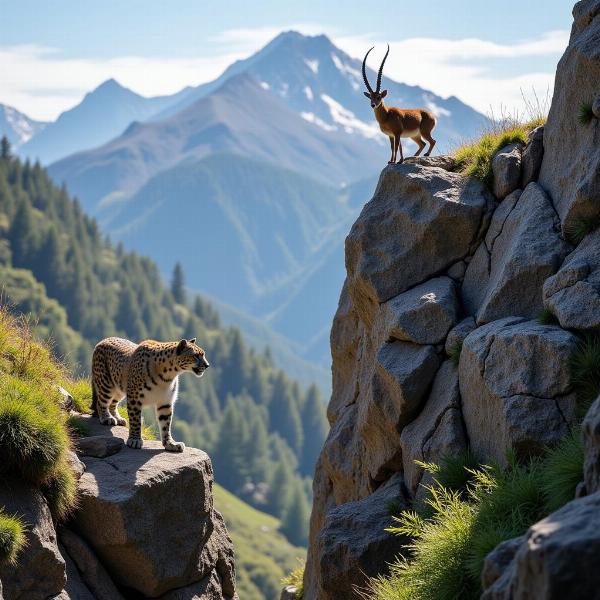Understanding the meaning of “indigenous species” is crucial for appreciating India’s rich biodiversity. “Indigenous species,” referring to plants and animals native to a particular region, translates to “देशी प्रजातियाँ” (deshi prajatiyan) in Hindi. This term highlights the importance of these species in maintaining the ecological balance of their natural habitat. Knowing the Hindi equivalent allows for more effective communication and understanding, especially when discussing conservation efforts and environmental protection within the Indian context.
Decoding “Deshi Prajatiyan”: A Deep Dive into Indigenous Species
The term “देशी प्रजातियाँ” (deshi prajatiyan) carries a deeper significance than just a simple translation. “Deshi” refers to something belonging to the land, while “prajatiyan” signifies species. Therefore, “deshi prajatiyan” emphasizes the intrinsic connection between these species and the Indian subcontinent. These are not just plants and animals found in India; they are integral to the very fabric of its ecosystems. Understanding this nuance is key to grasping the importance of their conservation. Think of the iconic Bengal tiger or the majestic Indian elephant – these are prime examples of deshi prajatiyan.
Why Indigenous Species Matter: Their Role in the Ecosystem
Indigenous species are fundamental to the health and stability of their ecosystems. They have adapted over millennia to the specific conditions of their environment, playing vital roles in maintaining biodiversity, nutrient cycling, and overall ecological balance. Their presence ensures the resilience of the ecosystem against disturbances and changes. Loss of these species can trigger a domino effect, impacting other organisms and the environment as a whole.
Threats to Indigenous Species and Conservation Efforts
Unfortunately, many indigenous species in India face numerous threats, including habitat loss, pollution, climate change, and invasive species. These pressures can lead to population decline and even extinction. Recognizing the importance of these species, various conservation initiatives are underway across India, focusing on protecting their habitats, combating poaching, and promoting sustainable practices.
Common Misconceptions about Indigenous Species
A common misconception is that all species found in India are indigenous. However, many species have been introduced from other parts of the world, either intentionally or accidentally. These introduced species, if they become invasive, can outcompete native species for resources and disrupt the ecological balance. It’s essential to differentiate between indigenous and introduced species to implement effective conservation strategies.
Examples of Indigenous Species Across India
India boasts a remarkable diversity of indigenous species, from the snow leopard in the Himalayas to the Nilgiri tahr in the Western Ghats. Each species contributes to the unique tapestry of India’s biodiversity. Learning about these species is the first step toward appreciating and protecting them. For example, the nilgiri meaning in hindi refers to the blue mountains, the home of the Nilgiri tahr.
 Snow Leopard and Nilgiri Tahr
Snow Leopard and Nilgiri Tahr
How You Can Contribute to Conservation
Everyone can play a role in protecting indigenous species. Simple actions like reducing your carbon footprint, supporting sustainable tourism, and spreading awareness about the importance of biodiversity can make a difference. You can also support organizations working to protect indigenous species and their habitats. Even understanding the maple meaning in hindi and its significance in the ecosystem can contribute to a broader appreciation for biodiversity. Likewise, knowing the zebra hindi name, although not native to India, can help in differentiating between indigenous and introduced species. Or understanding the kalahari meaning in hindi and its unique ecosystem can highlight the importance of preserving similar habitats in India. Perhaps learning the oran meaning in hindi, a port city in Algeria, might inspire you to explore the coastal biodiversity of India.
Conclusion
Understanding the meaning and significance of “indigenous species” or “देशी प्रजातियाँ” (deshi prajatiyan) is crucial for appreciating and conserving India’s rich biodiversity. By learning about these species and the threats they face, we can all contribute to their protection and ensure a healthy planet for future generations.
FAQ
-
What does “indigenous species” mean? Indigenous species are plants and animals that are native to a particular region.
-
Why are indigenous species important? They are vital for maintaining the balance of ecosystems.
-
What are some threats to indigenous species? Habitat loss, pollution, and invasive species are major threats.
-
How can I help protect indigenous species? Reduce your environmental impact, support conservation organizations, and spread awareness.
-
Where can I learn more about indigenous species in India? Many online resources and organizations provide information on this topic.
Meaning-Hindi.in is your trusted partner for all your Hindi translation needs. We offer a range of specialized translation services, including business and commercial document translation, legal and certified translation, technical and user manual translation, website and localization services, educational and academic document translation, and express translation. Our expertise covers a wide range of specialized fields, ensuring accurate and culturally sensitive translations. Need help with translating content related to indigenous species or any other topic? Contact us at [email protected] or call us at +91 11-4502-7584. Meaning-Hindi.in is committed to delivering high-quality translations that bridge language barriers and facilitate effective communication.